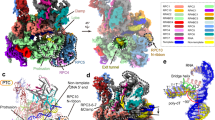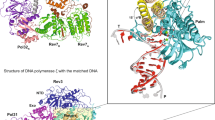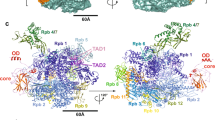Abstract
We have used triplet anisotropy decay techniques to study the flexibility of synthetic DNA fragments with different base pair compositions. We have found major differences in the torsional and bending stiffness of poly(dG)·poly(dC), poly(dA)·poly(dT) and poly(dA-dC)·poly(dT-dG). Poly(dG)·poly(dC) has a torsional modulus more than 40 times larger than poly(dA-dC)·poly (dT-dG), and approximately 20 times larger than poly(dA)·poly(dT). These differences imply that the torsional stiffness of DNA can vary greatly with base composition. The Young's modulus (bending stiffness) we have measured for poly(dG)·poly(dC) is at least twice that of poly(dA-dC)·poly(dT-dG) or random sequence DNA, and is at least threefold greater than that of poly(dA)·poly(dT). This implies that the bending stiffness of DNA is also strongly dependent on base composition. In light of this dramatic base composition dependence, we suggest here that such stiffness variation may lead to local variations in the stability of chromatin or other protein complexes that require bending or twisting of the DNA helix.
This is a preview of subscription content, access via your institution
Access options
Subscribe to this journal
Receive 51 print issues and online access
$199.00 per year
only $3.90 per issue
Buy this article
- Purchase on SpringerLink
- Instant access to full article PDF
Prices may be subject to local taxes which are calculated during checkout
Similar content being viewed by others
References
Hogan, M., Wang, J., Austin, R. H., Monitto, C. L. & Hershkowitz, S. Proc. natn. Acad. Sci. U.S.A. 79, 3518–3522 (1982).
Wang, J., Hogan, M. & Austin, R. H. Proc. natn. Acad. Sci. U.S.A. 79, 5896–5900 (1982).
Muller, W. & Crothers, D. M. Eur. J. Biochem. 54, 267–277 (1975).
Leslie, A. G. W. & Arnott, S. J. molec. Biol. 143, 49–72 (1980).
Hogan, M., Dattagupta, N. & Crothers, D. M. Proc. natn. Acad. Sci. U.S.A. 75, 195–199 (1978).
Crothers, D. M. & Muller, W. Cancer Chemother. Rep. 58, 97–100 (1974).
Robinson, B. H. et al. J. molec. Biol. 139, 19–44 (1980).
Schurr, J. M. & Allison, S. A. Biopolymers 20, 251–259 (1980).
Barkley, M. D. & Zimm, B. H. J. chem. Phys. 79, 2991–3007 (1979).
Landau, L. & Lifshitz, E. M. Statistical Physics (Addison-Wesley, Reading, 1958).
Kovacic, R. T. & VanHolde, K. E. Biochemistry 16, 1490–1498 (1977).
Gray, H. B. & Hearst, J. E. J. molec. Biol. 35, 111–129 (1968).
Millar, D. P., Robbins, R. J. & Zewail, A. H. Proc. natn. Acad. Sci. U.S.A. 77, 5593–5597 (1980).
Depew, R. E. & Wang, J. C. Proc. natn. Acad. Sci. U.S.A. 72, 4275–4279 (1975).
Finch, J. T. et al. Nature 269, 29–36 (1977).
Tatchell, K. & VanHolde, K. E. Biochemistry 16, 5295–5303 (1977).
Hogan, M. & Jardetzky, O. Biochemistry 19, 2079–2085 (1980).
LePecq, J. B. & Paoletti, C. J. molec. Biol. 27, 87–106 (1967).
Hogan, M., Dattagupta, N. & Crothers, D. M. Biochemistry 18, 280–288 (1979).
Author information
Authors and Affiliations
Rights and permissions
About this article
Cite this article
Hogan, M., LeGrange, J. & Austin, B. Dependence of DNA helix flexibility on base composition. Nature 304, 752–754 (1983). https://doi.org/10.1038/304752a0
Received:
Accepted:
Published:
Issue date:
DOI: https://doi.org/10.1038/304752a0
This article is cited by
-
Contour and persistence length of Corynebacterium diphtheriae pili by atomic force microscopy
European Biophysics Journal (2012)
-
Three-dimensional shapes of looped DNA
Meccanica (1996)
-
Stimulation of polydnavirus replication by 20-hydroxyecdysone
Experientia (1992)
-
Dependence of the torsional rigidity of DNA on base composition
Nature (1990)



